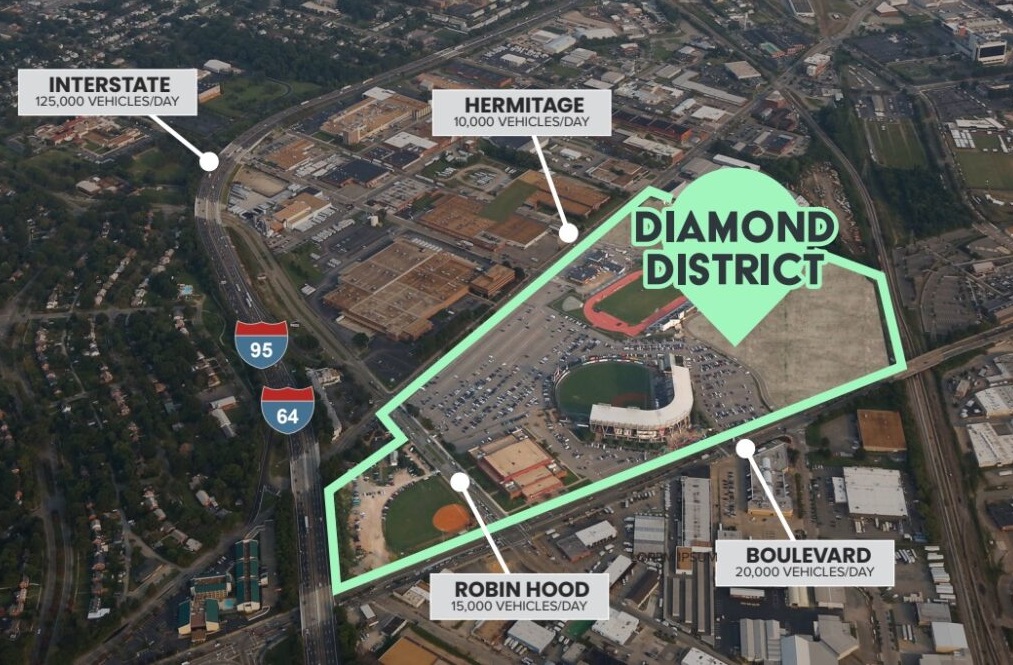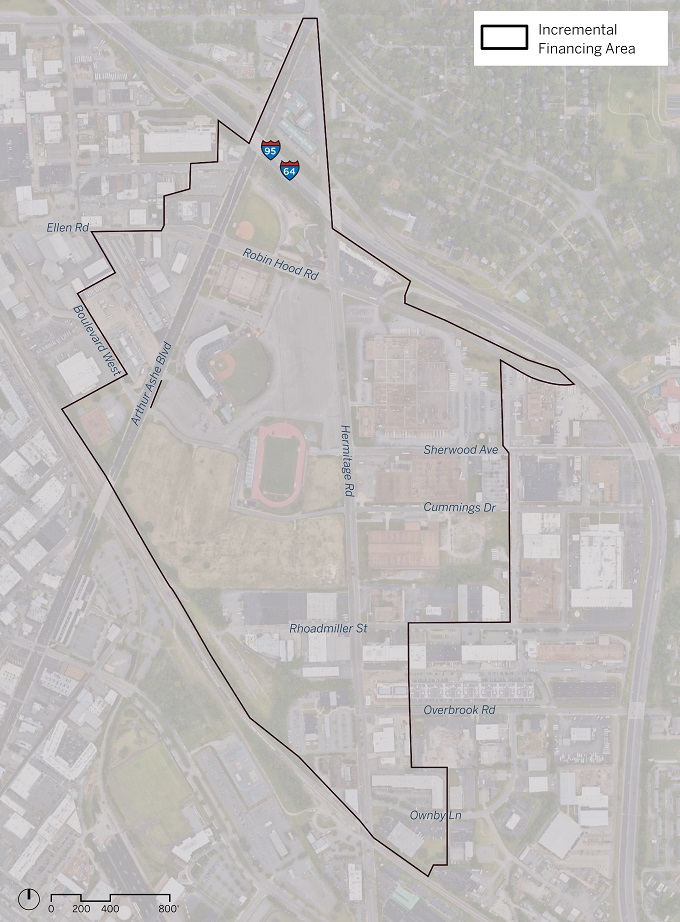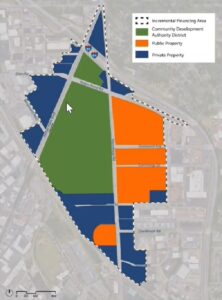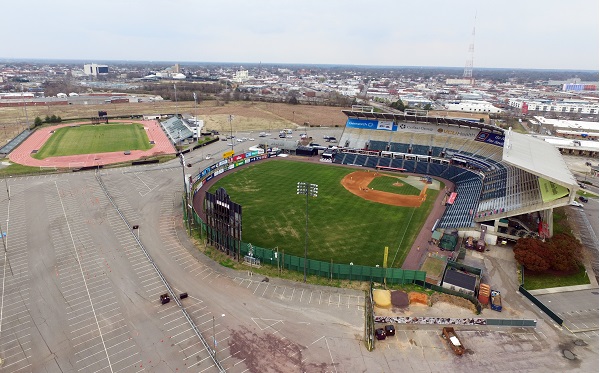
The 67-acre site is bordered by Arthur Ashe Boulevard, Hermitage Road, the interstate and the railroad tracks. (File image courtesy City of Richmond)
Final terms for what’s being touted as the biggest economic development project in Richmond’s history are slated to be approved by the City Council tonight.
Two weeks after the definitive agreements for the $2.4 billion Diamond District project were announced and introduced, the council is expected to approve the initial land transfer and development agreement with RVA Diamond Partners for the mixed-use project that includes a new stadium to replace The Diamond.
While the bulk of the overall project hasn’t changed since initial business terms were agreed to and approved last fall, the project’s financing plan is based on an expanded tax increment financing (TIF) district that includes privately owned properties beyond the 67-acre Diamond District site, the bulk of them adjacent to or across streets from the site.
Tax revenues from those properties would be used to help pay bonds for the new $90 million stadium, as well as public infrastructure improvements around the site along Arthur Ashe Boulevard and Hermitage and Robin Hood roads.
Officials have said the expanded TIF district is aimed at improving areas around the Diamond District to make it more accessible and connected with surrounding neighborhoods. The properties added to the district would not be charged additional taxes or fees, councilmembers were told in a committee presentation last week.
“This is not a special tax district; there are no tax surcharges,” said Leonard Sledge, the city’s economic development director.
“The rationale for doing this is to help address public comments seeking infrastructure improvements to connect the adjoining neighborhoods, and also to get us to tax-exempt financing, which will effectively save the city money,” Sledge said.
Nonrecourse bonds for the overall project are to be issued by a community development authority, or CDA, a financing method that local governments can use to help fund a project using tax revenues generated by that project over time.
Such revenues – from real estate, admissions and BPOL taxes, as well as portions of meals tax and state sales tax – would be restricted to those produced within the 67-acre Diamond District site.
RVA Diamond Partners, as the site’s property owner, also would pay a 2 percent hotel surcharge above the city’s lodging tax, and a 0.25 percent sales tax surcharge above the local option sales tax, that would likewise go toward paying the CDA bonds. The developer also would be responsible for a special assessment backstop to cover any shortfalls in generated revenue.
The developer would purchase the 60 acres that are under city ownership from Richmond’s Economic Development Authority, which would be the recipient of tonight’s land transfer. The remaining 7 acres that make up VCU’s Sports Backers Stadium would be purchased in a separate transaction with the university.
Expanded TIF district includes Thalhimer properties

A map shows across-the-street properties around the Diamond District that would make up the expanded TIF district.
CDAs have been used on such large-scale projects as Short Pump Town Center in Henrico, and are being used for Henrico’s arena-anchored GreenCity project.
Sledge said adding the nearby parcels to the TIF district allows the CDA to issue tax-exempt bonds and secure lower interest rates, and fund the additional infrastructure connections to adjacent neighborhoods. Proceeds from the property sale would be used to reduce the stadium bond debt.
While this isn’t the first time that a proposed TIF district has been expanded to support a public-private development project, the change for the Diamond District has not met the same reaction as the TIF that was proposed for Navy Hill, the $1.5 billion development plan that would have replaced the Richmond Coliseum and that a council majority ultimately rejected.

A map of the expanded TIF district shows privately owned properties in blue and publicly owned properties in orange. The CDA area, shown in green, consists of the 67-acre Diamond District site.
Where the Navy Hill TIF was expanded to include an 80-block swath of downtown, the Diamond District TIF expansion primarily involves land immediately adjacent to the project site, including properties planned for the VCU Athletics Village that would not be taxable due to the university’s ownership.
The privately owned portion of the expanded TIF includes multiple properties owned by Thalhimer Realty Partners, the local development firm that’s one of several firms behind RVA Diamond Partners.
Thalhimer’s holdings in the TIF include 2902 N. Arthur Ashe Blvd., the 3-acre site across from The Diamond where it’s co-developing Novel Scott’s Addition, a 272-unit apartment building.
Farther north along the boulevard, Thalhimer owns 1801 Ellen Road, where it’s planning a seven-story mixed-use building with 148 apartments, and 3064 N. Arthur Ashe Blvd., where it’s begun work on Scott’s Walk, a retail and restaurant project.
Along Hermitage Road south of the Diamond District site, Thalhimer also owns 1701 and 1717 Rhoadmiller St. and 2508 Hermitage Road, a cluster of warehouses it acquired in recent years that’s also included in a proposed expansion of the Hermitage Road Warehouse Historic District.
That expansion would extend eligibility for historic preservation tax credits to those properties and others added to the district. The process was kicked off last year with a preliminary information form filed on Thalhimer’s behalf. A public hearing on the historic district expansion is scheduled today at 5 p.m. at The Westbrook at Brewers Row clubroom at 1601 Overbrook Road.
Neither the TIF nor the historic district expansions include the former Pet Dairy property at 1501-1507 Robin Hood Road, which Thalhimer purchased in 2018.
Stadium deadline to be missed

The area that makes up the Diamond District includes the namesake baseball stadium and nearby Sports Backers Stadium. (BizSense file)
Thalhimer is partnering with D.C.-based Republic Properties Corp. and Chicago-based investment bank Loop Capital on the Diamond District, which is centered on replacing the 38-year-old Diamond with a new 9,000-capacity stadium.
Major League Baseball, which in recent years took over management for all pro baseball facilities, set the 2025 season as a deadline for both major and minor league venues to meet new facility standards, which The Diamond does not.
With less than two years remaining before that season, the city and RVA Diamond Partners have said they will not be able to meet the deadline but are aiming to complete the new stadium by spring 2026.
Negotiations between the parties to finalize the terms contributed to the delay, which both parties attributed to increases in interest rates.
At last week’s committee meeting, councilmembers asked if the city risks losing the Richmond Flying Squirrels, the minor-league ballclub that has called The Diamond home since 2010 and has been promised a new stadium ever since.
Noting a call with MLB that he said was scheduled in coming days, Sledge replied, “We have continued over the years to express our desire and our commitment. We’re putting action behind those words.”
“While we ideally would like to have the stadium open in time for Opening Day 2025, we remain confident, with the steps that we are taking in an expedited yet thorough manner and the financing plan in place, that we are able to continue to demonstrate by action our desire to continue to be a home for the Richmond Flying Squirrels and VCU Rams,” Sledge said.
Councilmembers who spoke in the committee meeting expressed support for moving the project forward. The final terms’ approval would tee up next steps, including completion of the ballpark’s design, creation of a Diamond District financing authority and the start of construction, which RVA Diamond Partners anticipates early next year.
Other steps include lease agreements with the Flying Squirrels and VCU, which also would use the new stadium. Lincoln Saunders, the city’s chief administrative officer, said the Flying Squirrels are awaiting such details before requesting a waiver from Minor League Baseball to go past the 2025 deadline.
“They’re going to be looking to see us moving forward on the development agreement, as well as further design and conversations about the financing of the stadium, before they are able to consider that waiver request,” Saunders said. “But I think they are enthusiastic about the progress and the idea of a new stadium for the Flying Squirrels here in the city.”
In addition to the new stadium, the Diamond District’s first phase would include 1,100 residential units, including lower-income units, 58,000 square feet of retail space, a 180-room hotel, structured and surface parking, an 11-acre public park and related infrastructure upgrades such as to roads and utilities.
With the finalized plan, the city would fund infrastructure upgrades for the first phase with $23 million in general obligation bonds. RVA Diamond Partners would remain responsible for infrastructure improvements in subsequent phases.
Minimum investment in the first phase has been projected at over $627 million, contributing to a total project development cost for the entire Diamond District area of $2.4 billion. The larger development, to include a mix of office, residential, retail and hotel uses and infrastructure improvements, is projected for completion over a 15-year period.

The 67-acre site is bordered by Arthur Ashe Boulevard, Hermitage Road, the interstate and the railroad tracks. (File image courtesy City of Richmond)
Final terms for what’s being touted as the biggest economic development project in Richmond’s history are slated to be approved by the City Council tonight.
Two weeks after the definitive agreements for the $2.4 billion Diamond District project were announced and introduced, the council is expected to approve the initial land transfer and development agreement with RVA Diamond Partners for the mixed-use project that includes a new stadium to replace The Diamond.
While the bulk of the overall project hasn’t changed since initial business terms were agreed to and approved last fall, the project’s financing plan is based on an expanded tax increment financing (TIF) district that includes privately owned properties beyond the 67-acre Diamond District site, the bulk of them adjacent to or across streets from the site.
Tax revenues from those properties would be used to help pay bonds for the new $90 million stadium, as well as public infrastructure improvements around the site along Arthur Ashe Boulevard and Hermitage and Robin Hood roads.
Officials have said the expanded TIF district is aimed at improving areas around the Diamond District to make it more accessible and connected with surrounding neighborhoods. The properties added to the district would not be charged additional taxes or fees, councilmembers were told in a committee presentation last week.
“This is not a special tax district; there are no tax surcharges,” said Leonard Sledge, the city’s economic development director.
“The rationale for doing this is to help address public comments seeking infrastructure improvements to connect the adjoining neighborhoods, and also to get us to tax-exempt financing, which will effectively save the city money,” Sledge said.
Nonrecourse bonds for the overall project are to be issued by a community development authority, or CDA, a financing method that local governments can use to help fund a project using tax revenues generated by that project over time.
Such revenues – from real estate, admissions and BPOL taxes, as well as portions of meals tax and state sales tax – would be restricted to those produced within the 67-acre Diamond District site.
RVA Diamond Partners, as the site’s property owner, also would pay a 2 percent hotel surcharge above the city’s lodging tax, and a 0.25 percent sales tax surcharge above the local option sales tax, that would likewise go toward paying the CDA bonds. The developer also would be responsible for a special assessment backstop to cover any shortfalls in generated revenue.
The developer would purchase the 60 acres that are under city ownership from Richmond’s Economic Development Authority, which would be the recipient of tonight’s land transfer. The remaining 7 acres that make up VCU’s Sports Backers Stadium would be purchased in a separate transaction with the university.
Expanded TIF district includes Thalhimer properties

A map shows across-the-street properties around the Diamond District that would make up the expanded TIF district.
CDAs have been used on such large-scale projects as Short Pump Town Center in Henrico, and are being used for Henrico’s arena-anchored GreenCity project.
Sledge said adding the nearby parcels to the TIF district allows the CDA to issue tax-exempt bonds and secure lower interest rates, and fund the additional infrastructure connections to adjacent neighborhoods. Proceeds from the property sale would be used to reduce the stadium bond debt.
While this isn’t the first time that a proposed TIF district has been expanded to support a public-private development project, the change for the Diamond District has not met the same reaction as the TIF that was proposed for Navy Hill, the $1.5 billion development plan that would have replaced the Richmond Coliseum and that a council majority ultimately rejected.

A map of the expanded TIF district shows privately owned properties in blue and publicly owned properties in orange. The CDA area, shown in green, consists of the 67-acre Diamond District site.
Where the Navy Hill TIF was expanded to include an 80-block swath of downtown, the Diamond District TIF expansion primarily involves land immediately adjacent to the project site, including properties planned for the VCU Athletics Village that would not be taxable due to the university’s ownership.
The privately owned portion of the expanded TIF includes multiple properties owned by Thalhimer Realty Partners, the local development firm that’s one of several firms behind RVA Diamond Partners.
Thalhimer’s holdings in the TIF include 2902 N. Arthur Ashe Blvd., the 3-acre site across from The Diamond where it’s co-developing Novel Scott’s Addition, a 272-unit apartment building.
Farther north along the boulevard, Thalhimer owns 1801 Ellen Road, where it’s planning a seven-story mixed-use building with 148 apartments, and 3064 N. Arthur Ashe Blvd., where it’s begun work on Scott’s Walk, a retail and restaurant project.
Along Hermitage Road south of the Diamond District site, Thalhimer also owns 1701 and 1717 Rhoadmiller St. and 2508 Hermitage Road, a cluster of warehouses it acquired in recent years that’s also included in a proposed expansion of the Hermitage Road Warehouse Historic District.
That expansion would extend eligibility for historic preservation tax credits to those properties and others added to the district. The process was kicked off last year with a preliminary information form filed on Thalhimer’s behalf. A public hearing on the historic district expansion is scheduled today at 5 p.m. at The Westbrook at Brewers Row clubroom at 1601 Overbrook Road.
Neither the TIF nor the historic district expansions include the former Pet Dairy property at 1501-1507 Robin Hood Road, which Thalhimer purchased in 2018.
Stadium deadline to be missed

The area that makes up the Diamond District includes the namesake baseball stadium and nearby Sports Backers Stadium. (BizSense file)
Thalhimer is partnering with D.C.-based Republic Properties Corp. and Chicago-based investment bank Loop Capital on the Diamond District, which is centered on replacing the 38-year-old Diamond with a new 9,000-capacity stadium.
Major League Baseball, which in recent years took over management for all pro baseball facilities, set the 2025 season as a deadline for both major and minor league venues to meet new facility standards, which The Diamond does not.
With less than two years remaining before that season, the city and RVA Diamond Partners have said they will not be able to meet the deadline but are aiming to complete the new stadium by spring 2026.
Negotiations between the parties to finalize the terms contributed to the delay, which both parties attributed to increases in interest rates.
At last week’s committee meeting, councilmembers asked if the city risks losing the Richmond Flying Squirrels, the minor-league ballclub that has called The Diamond home since 2010 and has been promised a new stadium ever since.
Noting a call with MLB that he said was scheduled in coming days, Sledge replied, “We have continued over the years to express our desire and our commitment. We’re putting action behind those words.”
“While we ideally would like to have the stadium open in time for Opening Day 2025, we remain confident, with the steps that we are taking in an expedited yet thorough manner and the financing plan in place, that we are able to continue to demonstrate by action our desire to continue to be a home for the Richmond Flying Squirrels and VCU Rams,” Sledge said.
Councilmembers who spoke in the committee meeting expressed support for moving the project forward. The final terms’ approval would tee up next steps, including completion of the ballpark’s design, creation of a Diamond District financing authority and the start of construction, which RVA Diamond Partners anticipates early next year.
Other steps include lease agreements with the Flying Squirrels and VCU, which also would use the new stadium. Lincoln Saunders, the city’s chief administrative officer, said the Flying Squirrels are awaiting such details before requesting a waiver from Minor League Baseball to go past the 2025 deadline.
“They’re going to be looking to see us moving forward on the development agreement, as well as further design and conversations about the financing of the stadium, before they are able to consider that waiver request,” Saunders said. “But I think they are enthusiastic about the progress and the idea of a new stadium for the Flying Squirrels here in the city.”
In addition to the new stadium, the Diamond District’s first phase would include 1,100 residential units, including lower-income units, 58,000 square feet of retail space, a 180-room hotel, structured and surface parking, an 11-acre public park and related infrastructure upgrades such as to roads and utilities.
With the finalized plan, the city would fund infrastructure upgrades for the first phase with $23 million in general obligation bonds. RVA Diamond Partners would remain responsible for infrastructure improvements in subsequent phases.
Minimum investment in the first phase has been projected at over $627 million, contributing to a total project development cost for the entire Diamond District area of $2.4 billion. The larger development, to include a mix of office, residential, retail and hotel uses and infrastructure improvements, is projected for completion over a 15-year period.





I hope this works out. Mostly it’s being done to create a a very expensive home for a Double A baseball team, one that generates very little revenue, if any, for the City. The city could have sold it all, block by block for redevelopment into a mixed use community and reaped tens of millions of dollars annually from the taxes. As it is, an expanded area of revenue producing developments will see their taxes tied up to pay down long term bonds for this project. Those bond obligations are likely to extend beyond the commercial viability of the new… Read more »
Even though you are probably correct about the ROI, I do hope this new ballpark works out. In fact, I wish this would secure the MLB give us a Triple A team back!
Or to see the bonds paid off! Unless it fails and then the moral obligation (which will be added just like the last two times we tried this in RVA) will be called and debt rolled into the city’s general fund just like that Broad Street CDA.
Agreed, Bruce. While this isn’t my preferred plan for this area, the plan so far along now I just want to see shovels in the ground on this long under utilized area.
exactly. The double-A team generates minimal revenue for the city. And the facility would only be used by the Squirrels and the Rams for what maybe 80 days a year and sit empty for the other 280? This is beyond dumb use of precious resources. But this is the city that agreed to an even bigger scam with the Redskins. What good is the rest of the growth in the Diamond District when all the incremental tax revenue for 30 years is siphoned off to a baseball facility for a private business? Essentially all the new residents and visitors to… Read more »
The park will obviously generate tax in a number of ways
If baseball fans want a new stadium, let them pay for it. The idea that this whole thing is wrapped up around a new stadium is beyond ridiculous. Put in a Chelsea Piers type sports facility that actually gets used by the community and you’d have something that’s financially viable on its own as well as being a genuine benefit to the region. Is the city still supposed to be forking over a couple mil just to bring the diamond up to MLBs arbitrary new standards, just so it can be used for another year? I live near the Diamond… Read more »
Has anyone paid attention to the fact that the price for the new stadium has increased from 80 million to 110 million dollars? That’s obscene ! I proposed a way to accomplish the stadium portion ( letter to the editor in the RTD) for 60 million.
Another issue that I haven’t seen addressed is parking for the stadium. I can’t identify it on any of the plans that I’ve seen.
Totally agree with you on the parking – it is definitely missing from the renderings…..
There will be no surface parking in the completed project. All public, residential, and business parking is to be structured. The land is too expensive to be covered with asphalt. This said, there may be some temporally parking on the undeveloped parcels prior to build out. As for stadium costs, there are two factors that have come to influence cost. The first is construction cost increases which are higher than the inflation rate. The second is the increase of the cost of borrowing to finance the stadium since the deal was announced last fall. These two issues are causing a… Read more »
Right Brian but that proposal required standing room only, PortoJohns, and six goats a grazing for the ground crew! (J/k)! Hello old friend!
Expect it to pass unanimously because Richmond city council will approve just about anything lately. More of the same.
I wish they would factor in youth sports tourism, like Henrico and Chesterfield have done. This brings in a lot of tax revenue. Maybe VCU can factor that in for both club sports and High School sports.